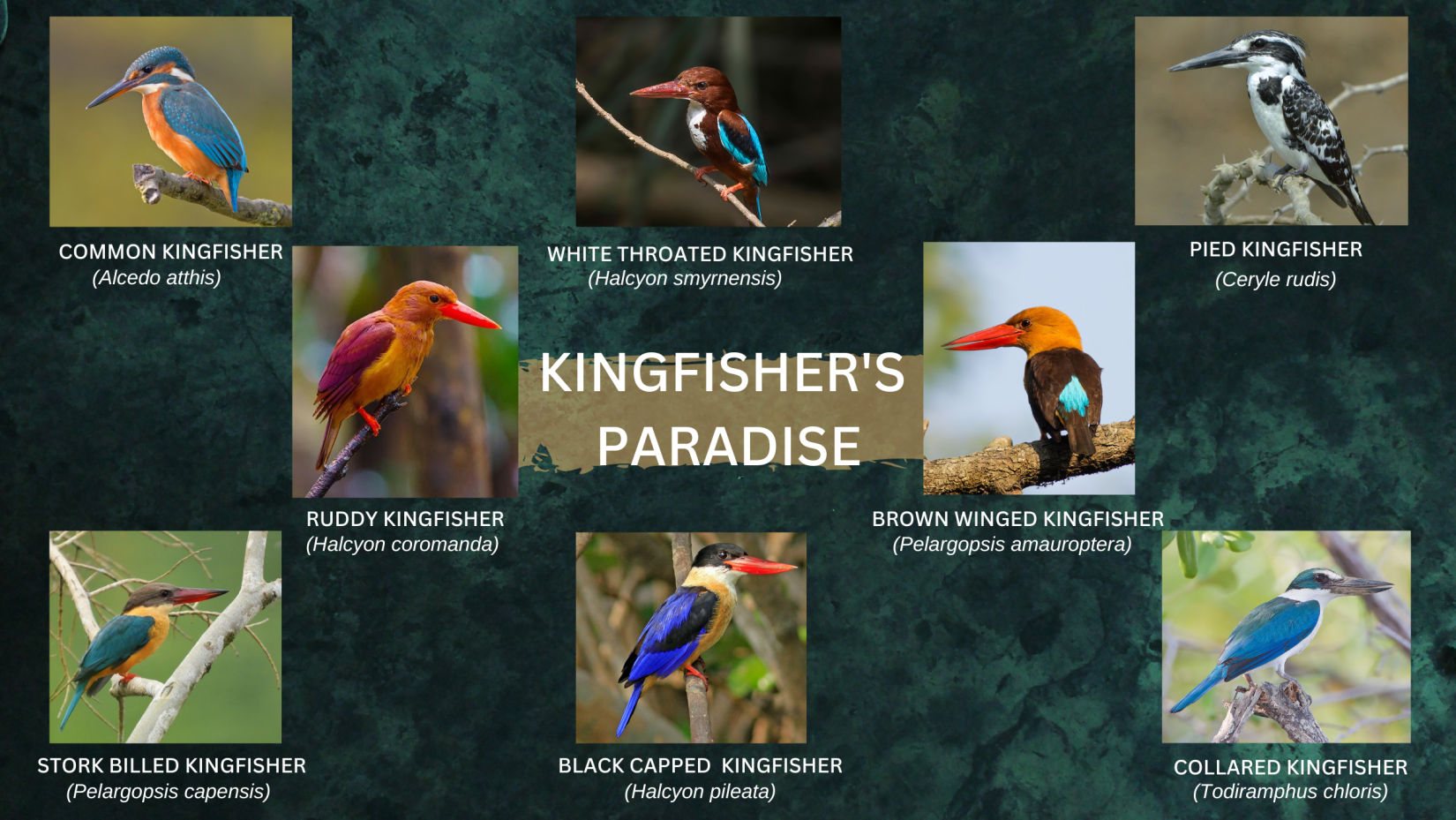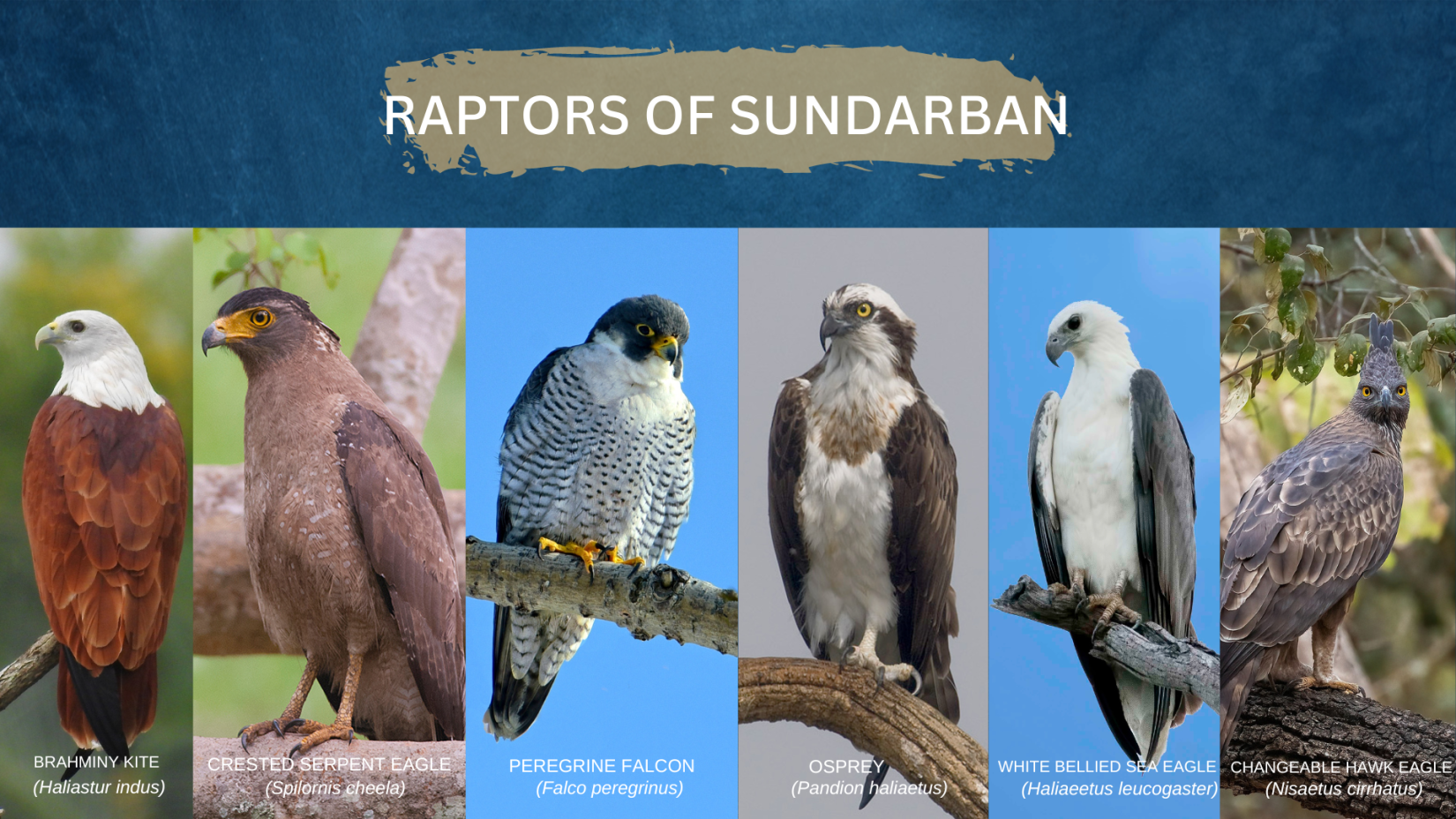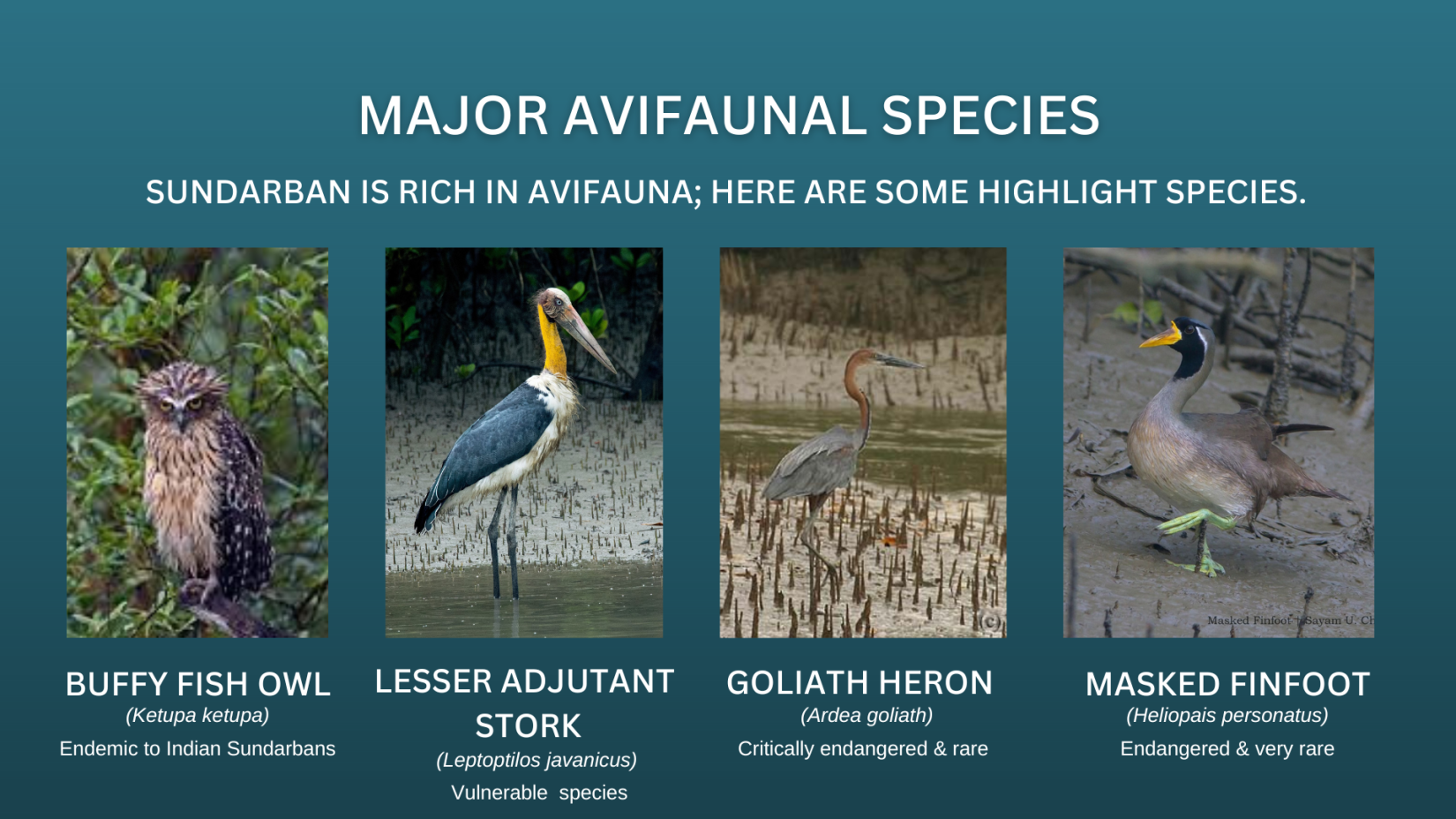Calling all bird lovers and enthusiasts! If you are seeking a birdwatching paradise, look no further than the wondrous Sundarbans National Park. Nestled in the Indian sub -continent plains, Sundarbans is a haven for diverse bird species.

KINGFISHER
Sundarbans is home to 8 species of Kingfishers out of 12 species which is found in India. Here are some of the details:
White-throated kingfisher: The white-throated kingfisher is the state bird of West Bengal and is commonly found in the villages of Sundarbans. Large-headed, predominantly brown kingfisher with electric-blue back and wings, heavy orange bill, and snow-white patch from the throat through the breast. Common both near and away from water; frequently seen perched on fence posts and telephone lines near wetlands, lakes, agricultural fields, and clearings. Gives jarring, raptor-like descending trills and cackles, often in flight.
Common kingfisher: Another common bird found throughout the Sundarbans. Beautiful little blue-and-orange bird with a long, pointed bill. Often rather shy and inconspicuous despite bright plumage. Found along rivers, streams, lakes, and ponds—almost any fresh or brackish habitat with small fish. Often perches quietly in trees over water; most often seen in very fast low flight as a turquoise flash over the water, usually flying away. Easily detected once its high, shrill whistled call is learned, even if the bird itself is hidden. The only small blue kingfisher over much of its range.
Pied Kingfisher: Boldly marked black-and-white kingfisher with short, bushy crest and glossy all-dark bill. Superficially similar to Crested Kingfisher, but smaller, with a much more distinctly patterned head and breast and less erect crest. Frequently seen perched in pairs or small groups. Often hovers over water when seeking prey. Inhabits a wide range of waterside habitats, from lakes to estuaries to mangroves. Gives a variety of sharp notes, as well as dry trilling and rattling calls.
Stork-billed Kingfisher: A seldom-seen bird. Massive kingfisher with a large scarlet bill. The head is olive-brown with dark green-blue upperparts and buff underparts. Wings and tail bluer, with rump even paler blue, obvious in flight. The Juvenile has dusky edges to feathers of breast and hindneck. Vocal in breeding season, giving a loud, far-reaching “peu-peu-pow” whistle, while its regular contact call is a loud laughing “ka-ka-ka” repeated 6-10 times. Prefers large streams, rivers, and the edges of large water bodies with vegetated banks.
Collared kingfisher: Gives carious vocalizations, but the most common call is a “kek-kek-kek-kek.” Frequents mangroves and tidal creeks, though sometimes inhabits other coastal habitats, including coconut plantations in islands. A mid-sized kingfisher with a variable plumage pattern; nearly 50 subspecies are described worldwide. All of them have a greenish-blue crown, a white spot above the lores, a black mask extending down as a narrow band across the hindneck, and a white collar. Upperparts are greenish-blue, rump brighter blue, with blue wings and tail and white underparts. Females and juveniles are slightly duller. Subspecies mainly differ in plumage, with upperparts varying from blue to green to olive-toned, white loral spot sometimes extending as a supercilium, and underparts sometimes buffier.
Black-capped Kingfisher: An unmistakable mid-sized kingfisher with a jet black head, white collar, and blood-red bill. It has purple-blue upperparts and pale orange-rufous underparts. The throat is white, the blue tail has a black underside, and in flight, white flashes on the underwings are conspicuous. The juvenile is duller blue with a small rufous-buff spot in front of the eye, a buffy collar, and dusky scaling on the breast. Calls similar to White-throated Kingfisher, but Black-capped’s are slightly higher-pitched. Frequents mangrove swamps and coastal wetlands, but often wanders up into hill streams.
Brown-winged Kingfisher: Chunky large orangish kingfisher with an oversized head and a scarlet dagger of a bill. No other large kingfisher in its range has dark brown wings. Bright blue-green rump patch most obvious in flight. Restricted to coastal habitats such as mangroves and estuaries. Gives loud, fluid-sounding whistles as well as harsh grating rattles.
Ruddy Kingfisher: One of the rarely seen kingfishers is the Ruddy Kingfisher which is only found during the monsoon season i.e. breeding season for them. Dark rusty-orange kingfisher with thick lipstick-red bill. Bright azure blaze on rump is most evident on flying birds. Shy and seldom seen in the open, instead preferring heavily shaded waterways in thick, tangled forests. Gives a loud descending rattle on breeding grounds; wintering birds silent.

RAPTORS
Sundarbans ecosystem holds a large population of different birds of prey (raptors). They can be easily seen. Some are residents others migrate during the winter season. Here some of the notable birds of prey that are easily found inside the mangrove forest:
Brahminy Kite: A medium-sized raptor with a rounded tail unlike other kites. Adults are unmistakable with a white head and breast contrasting with otherwise brick brown plumage. Juveniles are a darker brownish-black with a paler head and prominent white patches under the wings. Resident bird. Can be seen in pair.
Crested Serpent Eagle: A rather large, heavily built eagle with a dark, white-tipped bushy crest that gives it a distinctive large-headed look. When raised in alarm, the crest frames the whole face, highlighting the bare yellow lores and eyes, making the head look larger and fiercer. The rufous-brown underparts have neatly arranged dark-edged bold white spots. In flight, shows broad rounded wings with a wide black trailing edge. Juvenile predominantly white with dark streaks below; also note dark mask. Commonly seen perched upright in well-wooded areas, with wingtips nearly covering the broad white sub-terminal band on the tail. Its 1-3 note scream is often heard in the forest. Resident bird.
Changeable Hawk Eagle: Medium-sized eagle with massive rounded wings. Appears very small-headed in flight. Name is slightly misleading, as there are only really two color morphs, pale and black. Pale-morph adult is dark brown above with a white breast overlaid with dark streaks. Juvenile is much paler, with cleaner white underparts and less extensive striping and barring anywhere on the body. Dark morph is dark all over with paler outer wing feathers, and can be mistaken for dark Honey-Buzzards; look out for the hawk-eagle’s much longer wings and more slender profile. Inhabits forests, forest edges, and expansive parks and plantations. Resident bird.
White bellied Sea- Eagle: Enormous gray and white raptor that soars with wings held in strong V-shape. In flight note black and white underwing pattern, short tail. Juvenile is much browner and can be confused with Wedge-tailed Eagle, but note mostly pale and fairly short tail. Predominantly found along coastlines, as well as estuaries and inland waterways. Resident bird.
Osprey: Large, mostly white raptor that cruises over lakes, rivers, and coastal waterways in search of fish. Impressively widespread: found on every continent except Antarctica. Mostly white head and underparts; dark brown back. In flight, holds wings with a kink in the wrist (shaped like an "M"). Stick nests are conspicuous on top of channel markers, utility poles and high platforms near water. Often seen plunging feet-first into water from high in the air to grab fish. Migrate here during the winters.
Peregrine Falcon: One of the fastest animal in the world. Maximum recorded diving speed 390km/hr. Migrate here during winter. Sleek, fast-flying large falcon. Always look for a grayish back in adults, long wings that almost reach the tail tip and powerful but slender build. Dark mark below each eye varies in shape and size. Juveniles are more heavily patterned below than adults, and can be quite brownish above.

OTHER MAJOR AVIAN SPECIES
Here are some of the rarest and endangered species of bird found in the mangroves of Sundarbans.
Buffy fish Owl: Endemic to Indian Sundarbans. Seen mostly during the monsoon. Large orange-brown owl with prominent “horns” and bright yellow eyes. Brighter-colored than other large horned owls in the region. Roosts in dense foliage, but at dusk and during the night it perches out on exposed waterside branches, riverbanks, and even jetties. Secretive by day, but can be common in areas with suitable habitat. Gives a variety of calls, including loud wailing screams and soft hollow hoots.
Lesser adjutant Stork: One of the huge birds found in the mangroves. A large stork with a completely bare head and neck ideal for its scavenging habits. The adult’s face is red and the neck is yellow while the juvenile has a brownish head and a white, thinly-feathered neck. The upperparts are all dark while the underparts are mostly white. In flight, note the broad wings with distinctive white “armpits” and tucked-in neck. Similar to the larger Greater Adjutant; Lesser has a more slender bill, has all-dark upper wings, and often adopts a more upright, less “hunched” posture. Often found in shallow marshes, fields, and swamps.
Goliath Heron: One of the rare birds in this region. No recent sightings. This enormous heron stands 1.5 meters tall and has a robust, dagger-like bill. The immature has rustier upper wings than the adult. Its flight is ponderous and labored. Goliath Heron inhabits large rivers, marshes, estuaries, and mangroves, hunting for large fish and other animals, stabbing them with an open bill. It has a distinct, barking “kowoork” call that can be heard from up to 2 km away. Purple Heron has similar plumage, but Goliath Heron is twice the size, has a much larger bill, and has a rufous (not blackish) top of the head.
Masked Finfoot: One of the rarest birds found in this region. Historical records are available. A bizarre bird that loosely resembles a cormorant with a hornbill’s brightly-colored beak. Gray-brown overall with a black mask extending from the face down to the throat that is darker and more extensive in males. A reclusive species, typically encountered at dawn or dusk, skulking in well-vegetated waterways such as mangroves, swamps, and shaded rivers. Gives a loud odd bubbling call followed by an amphibian-like series of clucks.